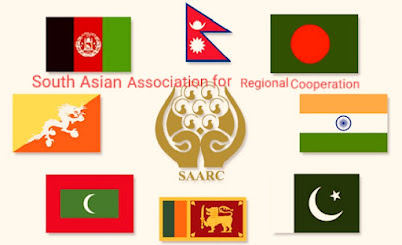The South Asian Association for Regional Cooperation (SAARC) is a regional intergovernmental organization established in 1985 to promote peace, development, and cooperation among South Asian countries. The eight member states—Afghanistan, Bangladesh, Bhutan, India, Maldives, Nepal, Pakistan, and Sri Lanka—share cultural similarities and historical ties. However, despite its potential, SAARC has not been able to function effectively in recent years. The future of SAARC depends on overcoming political tensions, enhancing economic collaboration, and focusing on people-centered development.
1.
The Need for a Stronger Regional Organization
South Asia is home to nearly a quarter of the world's population, yet it
remains one of the least economically integrated regions. Trade among SAARC
countries is low, poverty rates are high, and regional disputes often block
progress. In a globalized world, no country can thrive in isolation. The future
of SAARC lies in recognizing this interdependence and building a strong regional
platform that serves the common good. A united South Asia could become a
powerful economic and political block in global affairs.
2.
Political Challenges and the Way Forward
The biggest obstacle to SAARC's progress is political tension—especially
between India and Pakistan. This ongoing rivalry has repeatedly stalled SAARC
summits and disrupted cooperation. For the organization to have a future,
member states must prioritize diplomacy, peaceful dialogue, and conflict
resolution. SAARC must evolve from a political battleground into a forum for
problem-solving and collaboration.
Creating a neutral space within SAARC to address disputes and encouraging
backchannel diplomacy could ease tensions. Political willpower and a shared
vision of peace are essential for the survival and success of SAARC.
3.
Enhancing Economic Integration
Economic cooperation is one of the most promising areas for SAARC’s future.
By increasing intra-regional trade, creating common markets, and investing in
cross-border infrastructure, SAARC nations can boost economic growth and reduce
poverty.
Currently, trade among SAARC members accounts for less than 5% of their
total trade. This is due to high tariffs, poor connectivity, and political
mistrust. By simplifying trade policies, enhancing regional transport networks,
and encouraging private sector participation, SAARC can unlock immense economic
potential.
If handled wisely, regional trade could create jobs, reduce dependency on
foreign markets, and bring economic stability.
4.
Youth, Education, and Technology
A large percentage of South Asia’s population is young. Investing in
education, digital literacy, and innovation is crucial for a bright future.
SAARC should focus on building educational exchange programs, digital
universities, and research centers that promote regional cooperation in science
and technology.
Through shared knowledge and collective action, SAARC can prepare the
region’s youth for future challenges like automation, climate change, and
digital transformation. Joint research on agriculture, health, and disaster
management can benefit all member countries.
5.
Climate Change and Environmental Cooperation
South Asia is extremely vulnerable to climate change, including rising sea
levels, glacier melting, floods, droughts, and heatwaves. Countries in the
region share common environmental concerns, but their efforts to address them
are often uncoordinated.
SAARC must place climate action at the heart of its future agenda. Creating
joint environmental protection programs, sharing disaster management resources,
and launching a regional climate fund are practical steps. Only through
collective environmental responsibility can SAARC countries protect their
people and resources from the growing threats of climate change.
6.
SAARC and Regional Security
Security in South Asia is not just about war or terrorism—it also includes
food security, health security, and cyber security. The COVID-19 pandemic was a
reminder that crises do not respect borders. Regional collaboration on health
systems, vaccine distribution, and emergency response mechanisms should be a
future focus of SAARC.
The establishment of a SAARC Disaster Response Force, a regional health
monitoring center, and joint cyber security frameworks can make the region more
resilient to future challenges.
7.
Strengthening People-to-People Relations
Beyond governments, SAARC’s future depends on people. Building strong
people-to-people relationships through cultural exchanges, tourism, student
scholarships, and media cooperation can foster trust and mutual respect.
When people of South Asia see each other not as rivals but as neighbors with
shared dreams, the region will naturally move toward unity and peace. SAARC
must support civil society, youth groups, and academic institutions to lead the
way in connecting communities.
Conclusion
The future of SAARC is full of potential, but it will not be realized unless
member countries commit to meaningful cooperation, honest dialogue, and
people-centered development. The region faces common challenges—poverty,
climate change, youth unemployment, and health crises—that require collective
action.
If SAARC can transform itself from a symbolic organization into a practical
force for change, it can lead South Asia toward a peaceful, prosperous, and
sustainable future. The path is difficult, but not impossible—with shared
vision, trust, and regional unity, the dream of a stronger SAARC can become a
reality.












